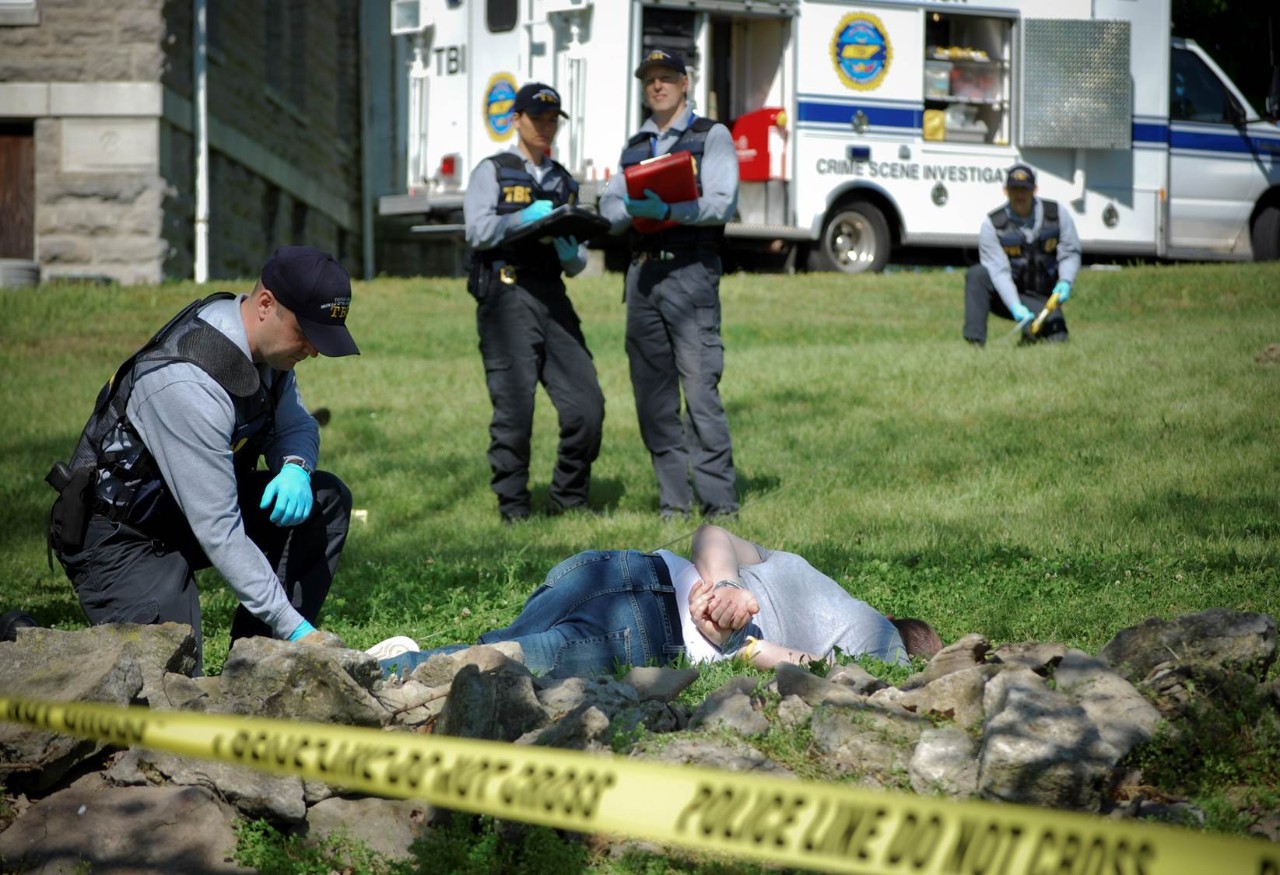Forensic Services Division
Providing quality forensic examinations in the pursuit of justice, with efficiency and transparency.
The TBI’s Forensic Services Division processes evidence for every law enforcement agency and medical examiner in the state. Because of the broad range of requirements they must possess, all TBI Forensic Scientists are commissioned by the Director as special agents, have earned a minimum of a bachelor's degree in Chemistry or a closely related scientific field, and have completed extensive training related to forensic science and crime scene investigation.
Forensic Science, the application of science to the law, has emerged as a major force in the attempts of the criminal justice system to control crime and to ensure a high quality of justice. The Special Agent/Forensic Scientists who work within TBI's Forensic Services Division (Crime Laboratory System) possess a wide array of analytical skills and direct their expertise to problems of reconstructing criminal acts, identifying and comparing physical and biological evidence, linking offenders with their victims and exonerating falsely accused persons. The Forensic Services Division provides forensic science services to any law enforcement agency or medical examiner in our state (T.C.A.§8-6-103, 38-7-110, 5510-410).
A Forensic Scientist must be skilled in applying the principles and techniques of the physical and natural sciences to the analysis of the many types of evidence that may be recovered during criminal investigations. However, in doing this, the scientist must also be aware of the demands and constraints that are imposed by the judicial system. The procedures and techniques that are utilized in the crime laboratory must rest on a firm scientific foundation and satisfy the criteria of admissibility established by the courts.
Our Forensic Disciplines
The Forensic Chemistry Unit analyzes any substance seized in violation of laws regulating the sale, manufacture, distribution, and use of abusive type drugs.
The Toxicology Unit conducts analysis of blood and other body fluids for alcohol, drug, or poisons, in conjunction with persons arrested for traffic charges (DUI) and a wide variety of other crimes.
The Latent Print Examination Unit provides analysis of physical evidence for invisible fingerprints and/or palm prints and comparison of latent prints developed with the known impressions of suspects.
TBI’s Automated Fingerprint Identification System (AFIS) is located in this unit, allowing latent lifts of unidentified latent fingerprints obtained from crime scenes or developed on evidence submitted to the laboratory to be searched against the database of fingerprint records maintained by TBI.
In addition, the Latent Print Unit has the capability of submitting unidentified latent prints from major crime scenes to the FBI for a fingerprint database search.
The Firearms Identification Unit’s principal function is to determine if a bullet, cartridge case, or other ammunition component was fired from a particular weapon.
The science of firearms identification extends beyond the comparison of bullets and cartridge cases to include knowledge of the operation of all types of weapons, toolmark examination, the restoration of obliterated serial numbers on weapons and other evidence, the detection and characterization of gunpowder residues on garments, and the estimation of muzzle-to-garment distance.
The Firearms Identification Unit also houses the National Integrated Ballistics Identification Network (NIBIN), allowing individual characteristics from evidence cartridge cases or test cartridge cases from submitted weapons to be searched against an ever-growing database and connect crimes that otherwise might never have been associated.
Scientists in TBI's Microanalysis handle a wide variety of evidence types and generally specialize in several of the following subdisciplines:
- Fire Debris Analysis: Debris can be examined to determine the presence of an unconsumed ignitable liquid, such as oil or alcohol.
- Gunshot Residue Analysis: This analysis is used to determine the presence of antimony, barium, and lead from hands of individuals who may have fired a gun or from crime-related objects, like clothing and vehicles.
- Impression Comparisons: Shoe and tire impressions recovered from the scene can be compared to known examples and a tire tread and shoe database.
- Explosive Residue: Detonated devices may be examined for the type of explosive contained in the device.
- Paint Analysis & Comparisons: Recovered paint evidence can be compared to known samples.
- Glass Fracture Analysis & Comparisons: Glass recovered from a scene can be compared to class recovered from objects associated with a subject, such as clothing and tools. Scientists can also analyze the direction and order of breakage.
- Fiber Comparisons: These can include individual fibers, as well as larger textile constructions, such as fabric or carpet. This analysis is often based upon microscopic examination and comparison, in conjunction with instrumental methods.
- Indented Impressions: These can be created when writing, drawing, or typing upon a top sheet of paper imparts an indentation on the sheet or sheets immediately below the page bearing the intended image.
- Tape Comparisons: A torn or cut end of tape recovered from a crime scene may be found to match the end of a recovered partial roll.
- Physical Comparisons: Scientists can associate two or more items using individual characteristics, such as fracture matches, or class characteristics, such as size, construction, or physical properties.
The Forensic Biology Unit performs identification and characterization of blood and other body fluids – liquid or dried, animal or human – present in a form to suggest a relation to the offense or persons involved in a crime. This unit also performs STR-DNA Profiling, the capability to identify specific individuals by comparing biological samples left at a crime scene or from the body of a victim. This unit also performs Y-STR DNA testing, allowing them to separate and identify small amounts of male DNA from the presence of large quantities of female DNA. Advances in DNA technology represent one of the most significant forensic breakthroughs of the century by allowing the identification of a murderer or rapist based on trace amounts of biological evidence left at the crime scene.
T.C.A. §40-35-321 required the TBI to establish a DNA database for convicted offenders that now includes individuals on the sexual offender registry. In 2007, an amendment added a DNA database for individuals arrested for violent felonies. These databases were established nationally by the Federal Bureau of Investigation to enable crime laboratories to exchange DNA profiles for unknown forensic samples, convicted offenders, and arrestees. The Combined DNA Index System (CODIS) assists agencies in developing investigative leads by enabling evidentiary DNA profiles to be searched against the database of convicted offenders and arrestees.
The Breath Alcohol Unit administers and maintains Tennessee’s breath alcohol testing program. Scientists assigned to this unit certify and calibrate evidentiary breath alcohol instruments throughout the state. The staff is responsible for training law enforcement personnel as operators on the instruments.
The Evidence Receiving Unit receives, inventories, distributes, and stores all evidence submitted to the laboratory.
Jackson
- Evidence Receiving
- Forensic Chemistry
- Toxicology
- Breath Alcohol
- Forensic Biology
- Firearms Identification
- CODIS
Nashville
- Evidence Receiving
- Forensic Chemistry
- Toxicology
- Breath Alcohol
- Latent Print
- Firearms
- Microanalysis
- Forensic Biology
- CODIS
Knoxville
- Evidence Receiving
- Forensic Chemistry
- Toxicology
- Breath Alcohol
- Forensic Biology
TBI's Violent Crime Response Teams

In order to more efficiently work violent crime or law enforcement use-of-force scenes, the TBI maintains three specially designed crime scene vehicles equipped with the most advanced forensic equipment and materials available. These crime scene vehicles are regionally located in Jackson, Nashville, and Knoxville and are primarily used by the TBI to assist in processing homicide crime scenes.
Violent Crime Response Teams are made up of Special Agent/Forensic Scientists with expertise in Firearms and Toolmark Analysis, Latent Prints, Microanalysis/Trace evidence, Serology/DNA, and Documentation. As a team, they travel to the crime scene wherever and whenever it occurs, and then locate, document, and collect any physical evidence that may identify the perpetrator, or that may be compared to a suspect who is developed later on in the investigation.
Virtual Tour: Nashville Crime Laboratory
